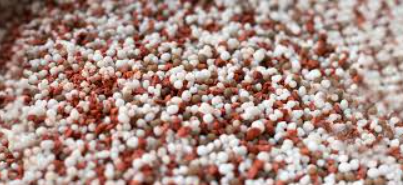Phosphates in Food Processing: From Baking to Dairy Applications
Phosphates are a group of essential chemical compounds that play a critical role in modern food processing. Found naturally in many foods and widely used as additives, they are valued for their ability to improve texture, stability, flavor and shelf life. From the fluffiness of baked bread to the creaminess of processed cheese, phosphates quietly enhance everyday products that consumers often take for granted.
Their versatility is one of the key reasons they remain indispensable across the
food industry. In baking, phosphates help regulate acidity and provide leavening support, ensuring consistent quality in breads, cakes and pastries. In the meat sector, they retain moisture and tenderness, while in dairy products, they improve meltability, texture, and stability. Even beverages benefit, as phosphates are used to balance acidity and preserve flavor.
Despite these advantages, phosphates have sparked debate in recent years. Supporters emphasize the proven safety and critical functionality of their product, while critics raise concerns about potential health risks associated with overconsumption. This tension between functionality and consumer health has pushed food manufacturers to consider both reformulation and the search for viable alternatives.
This article takes a closer
look at phosphates in food processing, with a particular focus on their use in baking and dairy applications. We will explore their benefits, challenges, and the future of phosphate alternatives, offering insight into why these compounds remain both essential and contested in today’s food landscape.
What Are Phosphates and Why Are They Important in Food Processing?
Definition and Types of Phosphates Used in Foods
Phosphates are salts and esters of phosphoric acid, widely used as multifunctional ingredients in the food industry. Naturally present in many foods, they are also added in controlled forms to improve quality and processing efficiency. Common food-grade phosphates include sodium, potassium, calcium and ammonium salts. Each serves a specific purpose: sodium phosphates are frequently used in processed meats and baked goods, potassium phosphates help regulate acidity, calcium phosphates provide mineral fortification and act as leavening agents, while ammonium phosphates support dough strength and texture.
Functional Properties in Food Systems
Phosphates are prized for their versatility. As buffering agents, they help maintain stable pH levels, critical for product consistency and microbial control. Their emulsifying properties allow fats and water to blend smoothly, which is essential in dairy products, sauces, and spreads. Water retention is another key function—phosphates bind moisture, ensuring meats remain juicy and baked goods retain softness. In baking, they contribute to leavening, helping dough rise evenly, while in beverages and dairy products, they stabilize proteins and prevent separation. Together, these properties make phosphates indispensable for ensuring both quality and consumer appeal.
Regulatory Landscape
Despite ongoing debates, phosphates are generally regarded as safe when used within established limits. In the United States, the Food and Drug Administration (FDA) classifies most food phosphates as GRAS (Generally Recognized as Safe). On a global scale, the Codex Alimentarius provides detailed guidelines on allowable levels and applications, ensuring harmonized food safety standards across international markets. These regulatory frameworks are designed to balance functionality with consumer protection, allowing manufacturers to leverage the benefits of phosphates while safeguarding public health.
Role of Phosphates in Baking Applications
Leavening Agents in Bread, Cakes and Pastries
One of the most important contributions of phosphates in baking lies in their role as leavening agents. When combined with sodium bicarbonate (baking soda), phosphates release carbon dioxide gas, which causes doughs and batters to expand. This reaction helps create the airy crumb and light texture that consumers expect in breads, cakes, and pastries. Different phosphate salts - such as sodium acid pyrophosphate (SAPP) or monocalcium phosphate (MCP) - are used to control the timing of gas release. Fast-acting phosphates produce immediate leavening during mixing, while slow-acting types continue releasing gas during baking, ensuring consistent volume and structure.
Texture and Moisture Retention
Beyond leavening, phosphates contribute significantly to the quality of baked goods by influencing texture and moisture balance. They improve the crumb structure, making it finer and more uniform, while also reducing the risk of large air pockets. By binding water, phosphates help maintain softness and prevent the product from drying out too quickly. This is especially important in packaged bakery items, where moisture retention translates to a fresher eating experience even after several days of storage.
Shelf-life Enhancement
Phosphates also play a role in prolonging the shelf life of baked products. Their buffering capacity helps stabilize pH, creating conditions less favorable for microbial growth. In addition, by slowing oxidative reactions, phosphates reduce the risk of rancidity in products containing fats. Together, these functions delay both staling and microbial spoilage, allowing bakeries and manufacturers to deliver products with reliable quality and longer market viability.
Clean-label Challenges in Bakery Products
Despite their technical advantages, phosphates face increasing scrutiny as consumers push for “clean-label” bakery items free from synthetic additives. While phosphates are safe and regulated, many shoppers now associate shorter ingredient lists and familiar names with healthier choices. This shift has challenged formulators to replace phosphates with alternatives such as natural leavening acids, sourdough fermentation, or enzyme-based solutions. However, achieving the same level of consistency, moisture control, and shelf-life without phosphates can be difficult and costly. As a result, bakeries must balance consumer expectations with product performance, making phosphates a focal point in the ongoing conversation about functionality versus transparency in food processing.
Phosphates in Dairy Processing
Role in Cheese Manufacturing
Phosphates play a pivotal role in cheese production, particularly in processed cheeses. Emulsifying salts, typically sodium or potassium phosphates, help blend natural cheese with additional ingredients like milk solids, water and fats. These salts alter the protein structure, allowing fats and water to mix uniformly, which results in a smooth, homogeneous texture. Beyond emulsification, phosphates improve meltability, processed cheese melts evenly without separating into oil and solids, making it ideal for cooking, sandwiches and ready-to-eat products. They also enhance sliceability and spreadability, contributing to consistent quality and consumer appeal.
Stabilization in Milk and Yogurt
In liquid dairy products such as milk and yogurt, phosphates serve as stabilizers and buffering agents. They help maintain pH levels within a range that prevents unwanted protein aggregation, which can lead to curdling or separation. By stabilizing casein micelles, phosphates ensure that milk-based beverages remain smooth and visually appealing over time. In yogurt, controlled phosphate addition can improve texture, giving a creamier mouthfeel and more uniform consistency. This functionality is especially valuable for commercial products, which require consistent quality during processing, packaging, and storage.

Applications in Ice Cream and Dairy Desserts
Phosphates also enhance frozen dairy products, including ice cream and dairy-based desserts. One key challenge in frozen foods is the formation of ice crystals, which can negatively impact texture and mouthfeel. Phosphates help bind water and stabilize proteins, reducing the formation of large ice crystals during freezing and storage. This results in a smoother, creamier product that retains its desired texture for longer periods. Additionally, phosphates improve emulsification in mixtures containing fats and water, ensuring uniformity and enhancing the overall sensory experience of ice cream, puddings, and custards.
By enabling these functions across cheese, milk, yogurt and frozen desserts, phosphates have become indispensable in modern dairy processing. Their ability to improve texture, stability, and shelf life allows manufacturers to deliver high-quality products consistently, while maintaining efficiency and meeting consumer expectations for taste and appearance.
Functional Benefits of Phosphates in Food Technology
Phosphates are valued in food technology for their ability to enhance multiple aspects of product quality and manufacturing efficiency. One of their primary benefits is improved consistency and texture. By interacting with proteins and other food components, phosphates help create uniform structures in baked goods, dairy products, processed meats and sauces. This results in smoother textures, consistent mouthfeel and visually appealing products that meet consumer expectations every time.
Another critical advantage of phosphates is their water-binding capacity. By retaining moisture, they prevent dryness in breads, cakes and meat products, while maintaining softness in dairy items like cheese and yogurt. Enhanced water retention not only improves sensory qualities but also extends freshness, reducing waste and ensuring that packaged foods maintain quality over longer periods.
Phosphates also play a key role in nutrient delivery, particularly for calcium fortification. Certain phosphate salts, such as calcium phosphate, are used to increase the mineral content of foods without negatively affecting taste or texture. This is especially important in dairy products, cereals, and fortified beverages, where maintaining bioavailability of added nutrients is crucial for both health and regulatory compliance.
From a manufacturing perspective, phosphates contribute to cost efficiency. Their multifunctional properties - emulsifying, stabilizing, buffering and moisture retention - allow manufacturers to achieve desired product qualities without relying on multiple separate additives. This simplification of formulation reduces production complexity, improves yield, and minimizes ingredient costs, making phosphates an attractive option for large-scale food processing.
In summary, phosphates enhance product consistency, texture, moisture retention, and nutrient delivery while supporting efficient manufacturing practices. These functional benefits make them indispensable tools in modern food technology, helping producers balance quality, cost and consumer satisfaction.
Health Concerns and Nutritional Implications
Excess Phosphate Intake and Human Health
While phosphates are essential nutrients required for bone health, energy metabolism, and cellular function, excessive intake can pose health risks. High levels of dietary phosphates - particularly from processed foods with added phosphates - may lead to hyperphosphatemia, a condition characterized by elevated phosphate levels in the blood. Over time, this can affect kidney function, as the kidneys are responsible for regulating phosphate balance. Individuals with compromised kidney health are especially vulnerable, as excess phosphate can contribute to mineral imbalances, cardiovascular complications, and decreased bone density. Even in healthy adults, chronically high phosphate consumption may subtly influence calcium-phosphate balance, potentially affecting bone strength over the long term.
Regulatory Intake Limits
To mitigate these risks, health authorities have established recommended dietary limits for phosphate consumption. The U.S. Institute of Medicine, for example, sets the tolerable upper intake level for adults at around 4,000 mg per day. Similar guidelines exist in Europe and other regions, often emphasizing that naturally occurring phosphates in whole foods are safer than highly bioavailable phosphate additives in processed products. However, research indicates that actual consumption - especially in populations with high intake of processed meats, cheeses and beverages - often exceeds recommended levels, highlighting the need for awareness and moderation.
Consumer Awareness and Label Scrutiny
Growing consumer interest in clean-label and minimally processed foods has increased scrutiny of phosphate additives. Many shoppers now read labels to identify ingredients such as sodium phosphate, potassium phosphate, or polyphosphates. Food manufacturers have responded by reformulating products, using alternative leavening agents, natural stabilizers, or sourcing minimally processed ingredients. Transparent labeling and education on phosphate content empower consumers to make informed choices, balancing the functional benefits of phosphates with overall dietary health.
In summary, while phosphates are valuable for food functionality, awareness of intake levels, adherence to regulatory limits, and informed consumer choices are essential to minimizing potential health risks. This balance allows the food industry to continue leveraging phosphates’ benefits without compromising public health.
Clean Label Trends and Alternatives to Phosphates
The clean-label movement has reshaped consumer expectations, with growing demand for food products made from simple, recognizable ingredients. While phosphates remain highly functional, their chemical-sounding names often conflict with this trend. As a result, manufacturers are exploring natural alternatives that can deliver similar benefits without compromising transparency or product performance.
One promising avenue is the use of enzymes in bakery applications. Enzymes such as amylases and xylanases can improve dough handling, extend freshness, and enhance crumb softness, reducing the need for phosphate-based leavening agents. In addition, dietary fibers like citrus or oat fiber are being incorporated to retain moisture and improve texture naturally. For leavening, alternatives such as cream of tartar, sourdough fermentation, or glucono delta-lactone (GDL) offer phosphate-free ways to achieve volume and consistency in baked goods.
In dairy processing, stabilizers derived from natural sources - such as pectin, carrageenan, or locust bean gum - are increasingly used to replace phosphate-based stabilizers. These ingredients help maintain protein stability and creaminess in yogurt or milk drinks. Meanwhile, in cheese-making, citrate salts or blends of natural emulsifiers can substitute for traditional phosphate emulsifying salts, though achieving the same meltability and smooth texture remains a technical challenge.
The industry shift toward phosphate-free formulations is gaining momentum, driven by both consumer demand and retailer requirements for cleaner labels. Case studies highlight this transition: some bakery brands now market breads and cakes with “phosphate-free” labels, emphasizing sourdough or enzyme-based solutions. Similarly, dairy companies have launched yogurts and processed cheese alternatives stabilized with natural hydrocolloids, appealing to health-conscious consumers.
While these innovations show promise, replicating the multifunctionality of phosphates remains complex. Alternatives often require tailored formulations and can increase production costs. Nevertheless, the clean-label trend continues to push research and development, positioning phosphate-free products as a growing segment of the food industry.
Future of Phosphates in Food Processing
The future of phosphates in food processing will likely be defined by balance, between their proven functionality and rising consumer demand for cleaner, more natural ingredient lists. While phosphates remain highly effective for leavening, stabilization, and moisture retention, their chemical perception and nutritional concerns have made them a target for reformulation efforts.
Innovations in phosphate substitutes are already shaping this transition. Enzyme technologies, natural leavening agents, and plant-derived stabilizers are increasingly being used to replicate key phosphate functions in bakery and dairy applications. Advances in fermentation-based ingredients and hydrocolloids offer promising solutions, though they often require complex reformulation and may not fully match the versatility of phosphates.
Regulation is also expected to play a larger role in the future. Health authorities may tighten guidelines on maximum phosphate levels in processed foods, reflecting both scientific evidence and consumer concerns. At the same time, global adoption of clean-label trends suggests that phosphate-free alternatives will become more widespread, particularly in premium and health-oriented product lines.
Overall, the path forward is not about eliminating phosphates entirely but about redefining their role within a broader toolbox of functional ingredients. Manufacturers who can balance performance, cost efficiency, and consumer expectations will be best positioned to navigate this evolving landscape.
FAQs on Phosphates in Food Processing
Are phosphates safe to consume in food?
Yes, phosphates are considered safe when consumed within regulated limits. They are classified as Generally Recognized as Safe (GRAS) by the U.S. Food and Drug Administration (FDA), and their use is permitted under Codex Alimentarius guidelines. However, excessive intake - often from processed foods with added phosphates - can pose health risks, particularly for individuals with kidney issues.
Why are phosphates used in processed cheese?
Phosphates act as emulsifying salts in processed cheese. They modify protein structures, allowing fats and water to blend smoothly. This prevents oil separation and creates the creamy, uniform texture that makes processed cheese easy to slice, spread, and melt evenly during cooking.
Can baking be done without phosphates?
Yes, baking can be achieved without phosphates, but results may differ. Traditional methods like sourdough fermentation or the use of cream of tartar as a leavening acid can replace phosphate-based agents. However, phosphates provide reliable and controlled leavening, making them difficult to replicate exactly in large-scale commercial baking.
What are natural alternatives to phosphates?
Natural alternatives include enzymes (such as amylases to improve bread softness), plant-based fibers for moisture retention, and hydrocolloids like pectin or carrageenan in dairy stabilization. In leavening, options include cream of tartar, glucono delta-lactone, or natural fermentation processes. These alternatives are increasingly used in clean-label products.
Do phosphates add any nutritional value?
Yes, certain phosphates contribute minerals such as calcium and phosphorus, both of which are essential for bone and cellular health. Calcium phosphates are often used in fortified foods to enhance nutritional value. However, the main reason for phosphate use in food processing is functional, not nutritional.
Conclusion
Phosphates have long been indispensable in food processing, particularly in baking and dairy applications. From creating the airy structure of bread and cakes to improving the meltability of cheese and the stability of yogurt, their versatility has made them one of the most relied-upon functional ingredients in modern food technology. Their ability to enhance texture, retain moisture, extend shelf life, and even contribute to nutrient delivery underscores their central role in ensuring both product quality and manufacturing efficiency.
At the same time, health concerns surrounding excessive phosphate intake have sparked growing debate. While regulatory agencies affirm the safety of these products within established limits, rising consumer awareness has shifted attention toward ingredient labels and the search for phosphate-free alternatives.
Looking ahead, the challenge lies in striking a balance: preserving the functionality and cost efficiency that phosphates provide, while embracing innovation that responds to clean-label trends and evolving consumer expectations. Phosphates remain vital to today’s food industry, but the future will likely see them share the stage with new, natural solutions designed to deliver the same benefits with greater transparency.
















